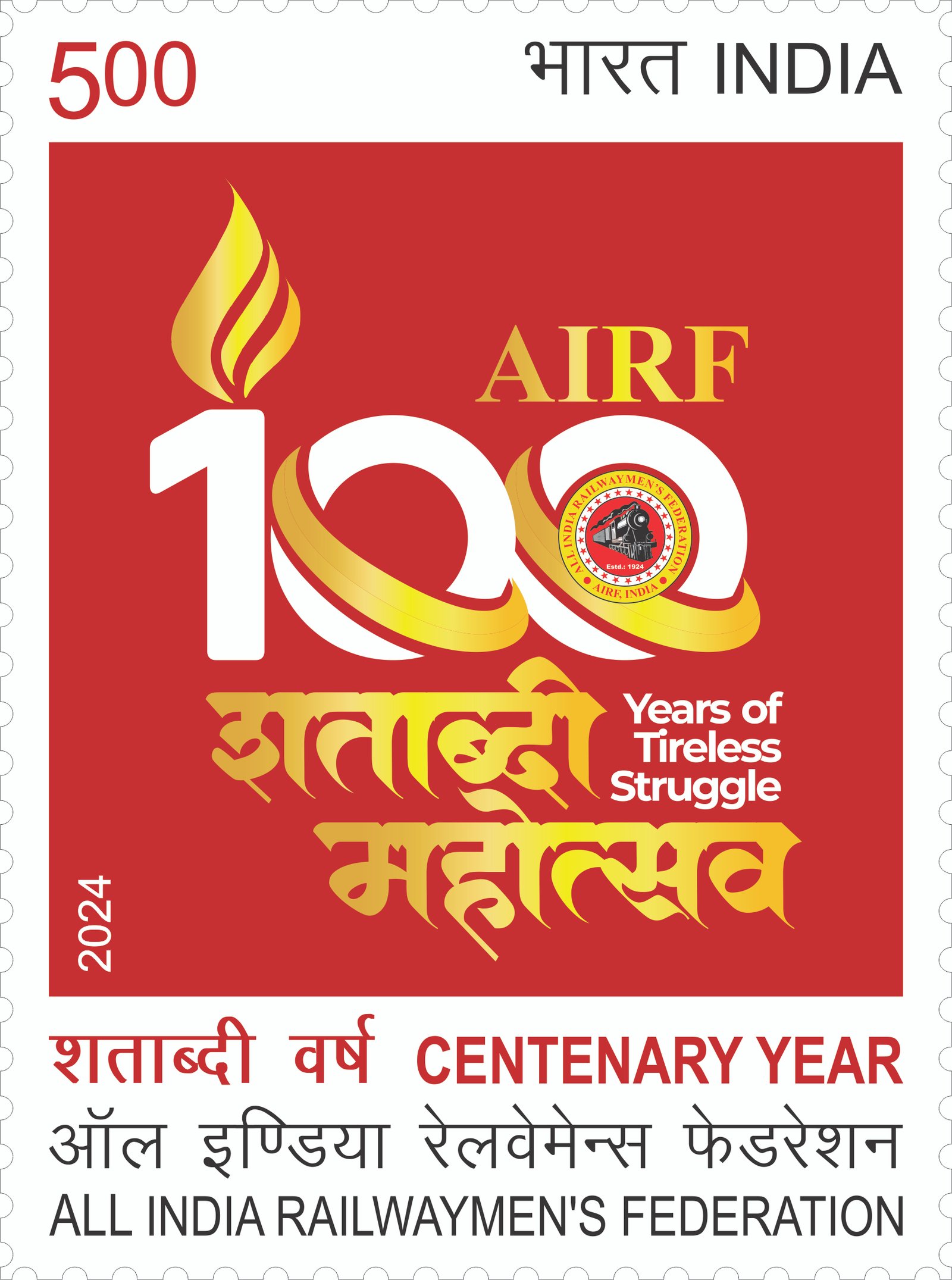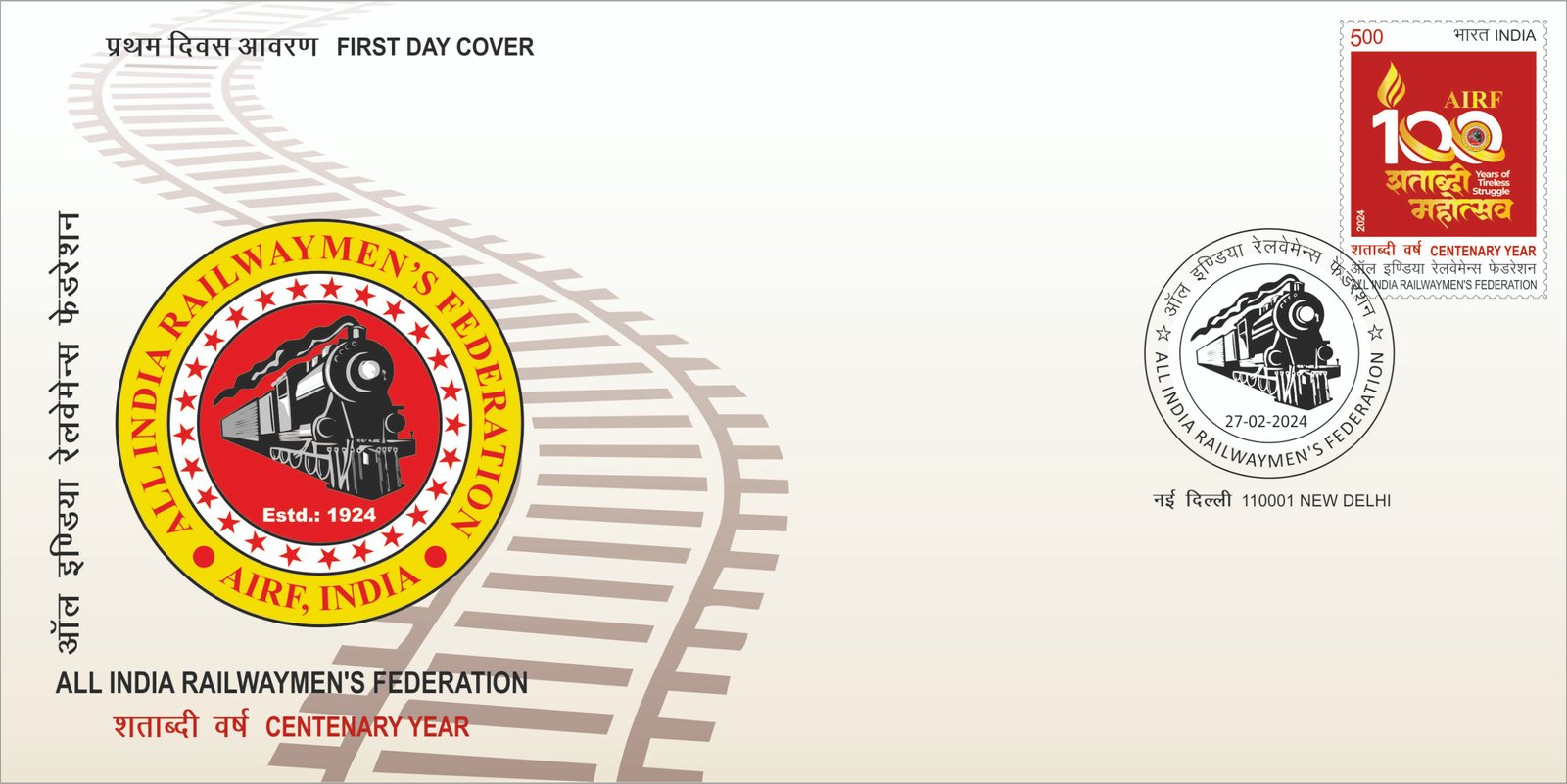Centenary Year All India Railwaymen’s Federation

Technical Data
| Date of Issue | February 27, 2024 |
|---|---|
| Denomination | Rs. 5 |
| Quantity | 304,100 |
| Perforation | 13¾ x 13¼ |
| Printer | Security Printing Press, Hyderabad |
| Printing Process | Wet Offset |
| Watermark | No Watermark |
| Colors | Multicolor |
| Credit (Designed By) | Ms. Nenu Gupta |
| Catalog Codes |
Colnect codes IN 2024.02.27-01 Yvert et Tellier IN 3635 Stanley Gibbons IN 3903 |
| Themes | Anniversaries and Jubilees | Labour Organisations | Railways | Seals(Emblems) |
A Tribute to 100 Years of Unity and Struggle
The All India Railwaymen’s Federation (AIRF) Centenary Stamp celebrates one of the most powerful trade union movements in India’s history. Established on 24 April 1924, the AIRF played a pivotal role in safeguarding the rights of railway workers and shaping the labor movement in India. This commemorative stamp not only honors the sacrifices of thousands of railwaymen but also reflects the Federation’s century-long journey of resilience, unity, and contribution to the nation.
Origins of the AIRF – Fighting Racial Discrimination
The roots of AIRF lie in the early trade union movement during the British regime. Indian railway workers faced severe racial discrimination, receiving lower pay and poorer service conditions compared to their European and Anglo-Indian counterparts despite performing the same work. To challenge this injustice, national leaders called for a unified body to coordinate the growing number of small unions across India’s railway network. This led to the foundation of the All India Railwaymen’s Federation in 1924, marking a new era in organized labor.
Role in India’s Freedom Struggle
The Indian Railways, being a strategic industry, became an important arena in the fight against British imperialism. The AIRF mobilized railwaymen to participate in agitations and protests that aligned with the freedom movement. From 1928 onwards, regular negotiations between AIRF and the Railway Board began, resulting in significant improvements in workers’ service conditions.
During the Second World War, inflation eroded wages drastically. AIRF fought tirelessly, leading to the introduction of the Dearness Allowance (DA)—a landmark benefit for employees. In 1946, after strong agitation, the First Pay Commission was formed, which abolished the discriminatory wage system between Indian and Anglo-Indian workers.
Legendary Leaders and Milestones
Over the decades, AIRF was guided by towering national leaders such as:
- V.V. Giri – later the President of India
- Lok Nayak Jayaprakash Narain
- George Fernandes – who famously led the 1974 railway strike
- Umraomal Purohit and other veteran trade unionists
These leaders not only defended workers’ rights but also unified railway unions across the country.
Struggles, Strikes, and Reforms
AIRF spearheaded three historic national strikes—in 1960, 1968, and 1974. The 1974 strike, under George Fernandes, was one of the largest industrial actions in independent India and significantly challenged the government of the time.
AIRF’s efforts led to several structural reforms, including the Railway Workers Classification Tribunal (1979) and successive Cadre Restructuring Committees (1984, 1993, 2003, 2013). These initiatives upgraded workers’ skills, improved wages, and expanded promotional opportunities.
The Federation’s persistent demands also influenced successive Pay Commissions (1946, 1957, 1970, 1983, 1994, 2006, and 2016), ensuring fair wages and benefits for railway employees.
AIRF Centenary 2024 – A Stamp of Legacy
As AIRF completes 100 years in 2024, the All India Railwaymen’s Federation Centenary Stamp stands as a philatelic tribute to its century-long journey. The stamp symbolizes:
- The struggle against colonial injustice
- The role of railwaymen in India’s freedom movement
- The continuous fight for workers’ rights in independent India
The centenary celebrations in New Delhi highlight AIRF’s evolution from a movement of resistance to a respected institution representing millions of railway employees.
Collectors’ Note
For philatelists, this commemorative postage stamp is more than a collectible—it is a historical symbol connecting the story of railways, labor rights, and India’s independence. Adding this stamp to a collection preserves not just postal history but a century of solidarity, struggle, and achievement of Indian railway workers.
First Day Cover

